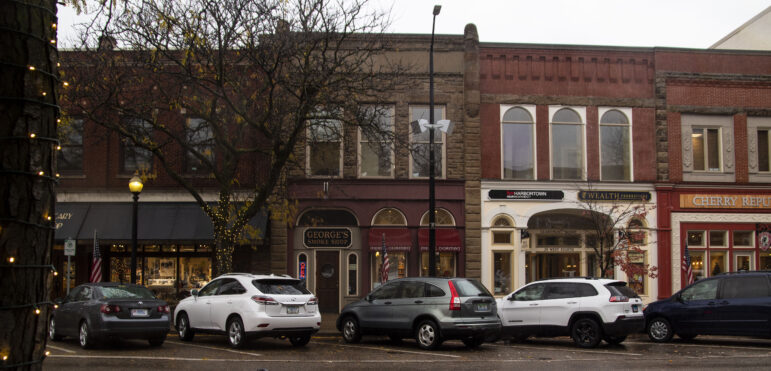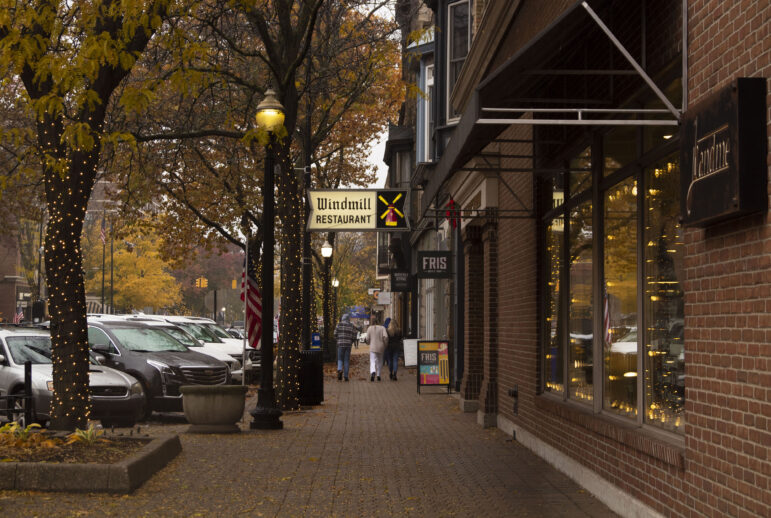
Downtown Holland. Image: Chloe Trofatter
By Anastasi Pirrami, Chloe Trofatter and Chloe West
Great Lakes Echo
Editor’s note: A recent study evaluated the quality of 1,322 U.S. small cities by five measures. This story is part of a series taking a closer look at one measure as it relates to the 39 Michigan cities in the study.
HOLLAND – As the rain settled on this beach city, lights illuminated shops and restaurants along West 8th Street and artifacts of Dutch culture appeared from the City Hall to the Tulip Time Festival Center.
This small city nestled off Lake Michigan ranks number one in the state for quality of life in “Best Small Cities in America,” a study published by WalletHub, a personal finance website that tracks financial and other trends. It is one of five measures the study used to rank the desirability of small cities. (The other measures are affordability, economic health, education and health, and safety.)

Walkability is among the measures used to rank small cities on quality of life. Image: Chloe Trofatter
The study defined small cities as those with populations of 25,000-100,000 people. Prompted by the increased population shift from large cities into smaller ones, WalletHub compared more than 1,300 cities on five measures of livability: quality of life, affordability, economic health, education & health, and safety.
Quality of life was assessed by measures like average commute time, city walkability and number of bars, restaurants and cultural centers per capita.
Holland, Kalamazoo, Flint, Muskegon and Saginaw ranked in the top five of 39 small Michigan cities for the quality-of-life measure. The state’s lowest were Holt, Eastpointe, St. Clair Shores, Lincoln Park and Garden City.
Holland has over 25 eateries – including restaurants, coffee shops, and bars – in its downtown, according to the city’s website. Among them is Waverly Stone Gastropub, opened by Holland native Andy Westerlund in 2018.
The young restaurant survived the pandemic in-part because of the community, Westerlund said.
“I’ve lived here my whole life and that’s something that Holland has always had,” he said. “Even in 2008 when the economy was really bad, everyone kept it local and supported local businesses.”

The number of restaurants per capita is among the measures WalletHub used to rank small cities on quality of life. Image: Chloe Trofatter
Holland is also internationally known for its Tulip Time Festival, an annual city celebration of Dutch heritage and tulips in bloom with international entertainment acts, events and activities.
Gwen Auwerda, executive director of the Tulip Time Festival, has organized the event since 2011 and is currently planning her 12th festival. Auwerda said she comes back every year for the people and her love of collaboration.
“It’s really the people in the community and the volunteers that just come from wherever,” Auwerda said. “Many people have moved here because they came to Tulip Time or in the summer, and they’ve retired here or moved here with their families.”
Such opportunities for cultural and community connection contributed to Holland’s rank. “There are all kinds of amenities that have been built up in this community that makes this place a wonderful experience year-round,” said Nathan Bocks, Holland’s mayor.

Holland Mayor Nathan Bocks. Image: Chloe Trofatter
Holland has a five-mile network of heated sidewalks, Bocks said. “If you’re a walker or runner, you can do a five-mile run on clean, dry sidewalks on the snowiest day of the year.”
The city also has an extensive private and public park system in the downtown area. Van Raalte Farm has 20-acres of land maintained for activities like hiking and skiing.
These parks and Holland’s award-winning seasonal plantings – more than just tulips, but various annuals and perennials for spring, summer, fall and winter – are a result of city-wide cooperation, Bocks said.

Centennial Park in Holland’s downtown district. Image: Chloe Trofatter
“We partner with Hope College and local greenhouses and landscaping companies,” he said. “That’s just one example of a partnership between all of these different connected but not connected organizations saying, ‘how do we do things together to make this community a better place?’”
City Manager Keith Van Beek said Holland’s population has had marginal growth over the last decade. This is due, in part, to a larger trend of people leaving larger cities for more close-knit communities, Van Beek said.
“What we’re finding is that we have a lot of people that [are] not so much reflected in the 2020 Census numbers,” he said, “but we absolutely are hearing stories every week of people that are moving to Holland from larger communities.”
Heather Lewis, who is originally from Brighton, did just that. “It’s quieter,” she said. “It’s definitely more family-focused here.”
Lewis works part-time at Threads on 8th, a women’s boutique in Downtown Holland. In her free time, she volunteers as a hairstylist at Benjamin’s Hope, a non-profit that provides housing and care for adults with disabilities.
Although Holland ranks high in quality of life according to WalletHub’s metrics, there is room for improvement, said Arnold Weinfeld, Michigan State University’s associate director of the Institute for Public Policy and Social Research.
Weinfeld once worked with the Michigan Municipal League, an organization dedicated to community development and advocacy in Michigan. The group created a guide for place-making, a strategy for building community-centered public spaces and cities.
The guide highlights eight essential elements for place-making, such as cultural economic development, education, and public transit. It also emphasizes the importance of welcoming diversity and multiculturalism. Despite Holland’s culturally rich roots, it has previously struggled with being open to diverse communities, Weinfeld said.

This story is part of a series called “Small Cities.”
“Holland itself has gotten very diverse, especially with Spanish populations,” he said. “Holland Township, now, has grown, as there has been a bit of white flight from the city.”
Weinfeld attests to the city’s connected and robust downtown. “As a visitor, I can see where it has a high quality of life, but I’m not sure it would fall under being a welcoming community, as it still has some racial divides it needs to conquer.”
“And not just racial divides, but human rights divides,” he said.
In 2020, Holland expanded its anti-discrimination ordinance to protect members of the LGBTQ+ community in matters such as housing, employment, and public services. The ordinance was originally shot down by the Holland City Council in 2011, but championed by Bocks when he was elected mayor.
The city’s focus on improvements includes adding to the parks, shops and waterfront attractions and addressing affordable housing and diversity, equity and inclusion issues, Van Beek said.
“We are in the business of making a place where people want to live, work, play and visit,” he said. “We just want to be a place that’s welcoming to everybody and, as our mayor says, that everyone can call home if they choose and want to be here.”

The second column ranks the best 39 Michigan small cities – those between 25,000 and 100,000 people – based on all five factors weighed by a national study. The subsequent columns show their rank solely on that column’s measure. Source: WalletHub